Renaissance Male Fashion was defined by opulence, detail, and a distinct silhouette. At mens-fashion.net, we help you understand and incorporate these historical styles into your modern wardrobe. Explore our guide to recreate this timeless look, blending historical elegance with contemporary flair, ensuring you always look your best. We’ll cover key elements like doublets, ruffs, and hose, offering styling tips and where to find modern interpretations.
Table of Contents
- What Were the Key Elements of Renaissance Male Fashion?
- What Fabrics and Colors Were Popular in Renaissance Male Attire?
- How Did Social Status Influence Renaissance Men’s Clothing?
- What Were the Most Iconic Accessories for Renaissance Men?
- How Can You Incorporate Renaissance Elements into Modern Men’s Fashion?
- What Are the Best Resources for Learning About Renaissance Fashion?
- How Did Renaissance Fashion Differ Across Europe?
- How Has Renaissance Male Fashion Influenced Contemporary Designers?
- What Role Did Portraits Play in Understanding Renaissance Male Fashion?
- What Were the Practical Considerations in Renaissance Men’s Clothing?
- FAQ: Renaissance Male Fashion
1. What Were the Key Elements of Renaissance Male Fashion?
Renaissance male fashion, flourishing from 1550 to 1600, featured several distinctive elements. These include linen shirts with ruffs, fitted doublets, jerkins, various styles of hose, and outerwear such as cloaks and capes. According to the Fashion Institute of Technology (FIT) in July 2025, understanding these components is crucial to appreciating the period’s sartorial elegance. Each element combined to create a sophisticated and elaborate look that reflected the era’s cultural renaissance.
- Linen Shirt with Ruff: The foundation of any Renaissance outfit was a fine linen shirt, often adorned with a ruff—a stiff, ruffled collar. Initially small, ruffs grew in size over time, becoming a prominent status symbol. Matching wrist ruffs completed the look.
- Doublet: This close-fitting jacket was tailored to accentuate the body’s shape. It was a fundamental piece, worn in various styles and fabrics, often embellished with embroidery or slashing.
- Jerkin: Worn over the doublet, the jerkin was typically sleeveless and made of leather. It added another layer of sophistication and could be simple or highly decorated depending on the wearer’s status.
- Hose: Leg coverings came in numerous styles. Trunk hose, short and padded, were popular, sometimes worn with cannions (fitted hose extending above the knee). Slops (galligaskins) were looser, knee-length hose. Pluderhosen, a Northern European variant, had a voluminous inner layer visible through slashes. Venetians were semi-fitted hose reaching just below the knee.
- Outerwear: Short cloaks or capes were common, often hip-length with sleeves. Longer coats were worn in colder weather, and military-style jackets like mandilions were fashionable.
These core elements were often complemented by accessories such as hats, belts, and jewelry, each contributing to the overall aesthetic of Renaissance male fashion.
2. What Fabrics and Colors Were Popular in Renaissance Male Attire?
Renaissance male attire heavily favored luxurious fabrics and vibrant colors. Velvet, silk, and wool were commonly used, reflecting the opulence of the era. Rich colors like crimson, gold, deep blues, and purples were popular among the elite, while more subdued tones were worn by the lower classes. According to a study by the Victoria and Albert Museum, the choice of fabric and color was a direct indicator of social status and wealth during the Renaissance.
- Velvet: This plush fabric was a favorite for doublets, jerkins, and outerwear, offering both warmth and a rich texture.
- Silk: Prized for its sheen and lightweight feel, silk was often used for shirts, linings, and decorative elements like embroidery and trims.
- Wool: A practical choice for hose and outer garments, wool provided warmth and durability. Finer grades of wool were used for more luxurious items.
- Linen: Essential for shirts and undergarments, linen was valued for its comfort and breathability.
Color symbolism was also significant:
- Crimson and Red: Symbolized wealth, power, and nobility, often worn by royalty and high-ranking officials.
- Gold: Associated with opulence and divine status, used in embroidery, trims, and accessories.
- Deep Blues and Purples: Represented royalty and high social standing due to the expense of producing these dyes.
- Subdued Tones: Browns, grays, and greens were more common among the lower classes, reflecting their limited access to expensive dyes and fabrics.
The combination of luxurious fabrics and rich colors made Renaissance male attire a visual representation of the wearer’s status and wealth.
2.1. Detailing of the Common Men’s Fashion
| Clothing Items | Details |
|---|---|
| Linen shirt | Ruffs, matching wrist ruffs, later replaced by collars and matching cuffs |
| Doublet | Fitted and shaped, snugly fitting the body |
| Jerkin | Tight-fitting, sometimes worn over the doublet, usually sleeveless and made of leather |
| Hose | Trunk or round hose (short and padded), slops or galligaskins (loose hose below the knee), pluderhosen (Northern European pansied slops), venetians |
| Stocking | Often worn to cover the legs |
| Shoes | Flat with rounded toes, fastened by slashes until ties over the instep were adopted |
| Outerwear | Short cloaks or capes (hip-length with sleeves), longer coats in colder weather, military jackets (mandilions) |
| Headgear | Soft fabric hat with gathered crown (1570s), capotain or copotain (conical felt hat with rounded crown, later taller and decorated) |
| Coifs or Biggins | Close-fitting caps covering the ears and tied under ears |
| Nightcaps | Conical shaped and made of embroidered linen, worn indoors |
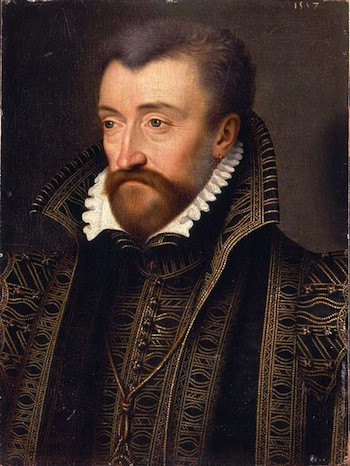
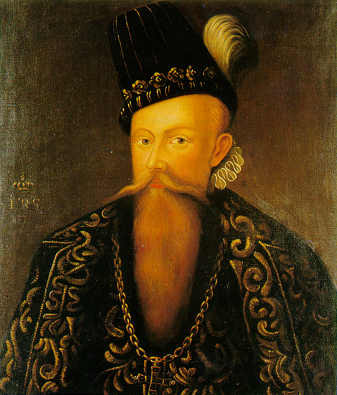
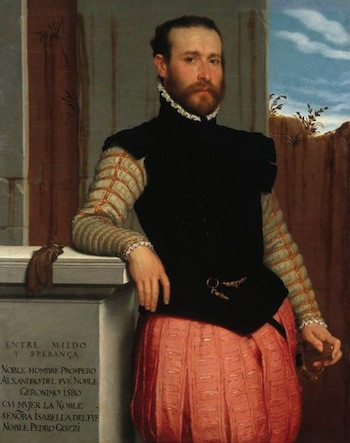
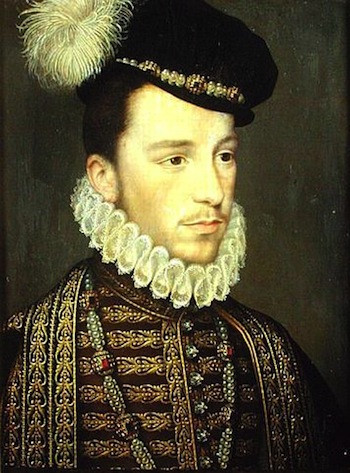
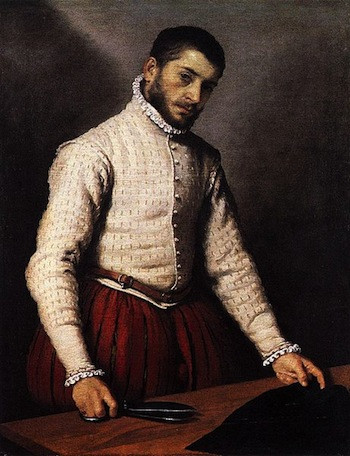
3. How Did Social Status Influence Renaissance Men’s Clothing?
Social status profoundly influenced Renaissance men’s clothing. The fabrics, colors, and embellishments worn were clear indicators of a man’s position in society. Royalty and nobility flaunted opulent materials and intricate designs, while commoners wore simpler, more practical garments. Historian James Laver’s “Taste and Fashion” (2002) explains that sumptuary laws often regulated what each social class could wear, reinforcing these visual distinctions.
- Royalty and Nobility: Members of the upper class adorned themselves in velvet, silk, and other expensive fabrics. Their clothing featured elaborate embroidery, gold and silver threads, and precious stones. Rich colors like crimson, purple, and gold were reserved for the elite.
- Merchants and Professionals: The middle class, including merchants and professionals, wore garments of good quality but less extravagance. Wool and linen were common choices, with some silk accents. Colors were more subdued, though they still incorporated some brighter hues to denote their status.
- Commoners: Laborers and peasants wore simple, functional clothing made from coarse wool or linen. Colors were typically muted and earthy, reflecting the practicality of their attire. Embellishments were minimal or nonexistent.
Accessories also played a role in signifying status. Elaborate hats, jewelry, and ornamented weapons were hallmarks of the upper classes, while simpler accessories were worn by those of lower status. The silhouette of the clothing itself could also indicate social standing, with more voluminous and layered garments suggesting greater wealth and leisure.
4. What Were the Most Iconic Accessories for Renaissance Men?
Renaissance men’s fashion was enhanced by various iconic accessories that added flair and status to their attire. These included ruffs, hats, jewelry, belts, and footwear, each playing a significant role in completing the Renaissance look. According to fashion historian Anne Hollander, accessories were crucial in conveying personal style and social standing during this period.
- Ruffs: These stiff, starched collars were among the most recognizable accessories. Ruffs grew in size and complexity over time, becoming a symbol of wealth and status. They were often made of fine linen and edged with lace.
- Hats: Headwear was an essential part of Renaissance fashion. Styles ranged from soft fabric hats with gathered crowns to conical capotains decorated with jewels or feathers. Hats were worn both indoors and outdoors and varied in style according to the occasion and social class.
- Jewelry: Men of the Renaissance adorned themselves with rings, necklaces, chains, and brooches. These pieces were often made of gold and embellished with precious stones, serving as symbols of wealth and power.
- Belts: Belts were functional and decorative, used to cinch the waist and display wealth. They were often made of leather or fabric and adorned with metal buckles and ornaments.
- Footwear: Shoes were typically flat with rounded toes, fastened with slashes or ties. Wealthier men wore shoes made of fine leather or velvet, often decorated with embroidery or jewels.
These accessories not only added to the aesthetic appeal of Renaissance men’s clothing but also communicated important messages about the wearer’s social standing, wealth, and personal style.
4.1. Examples of Iconic Accessories
| Accessory | Description |
|---|---|
| Ruff | Stiff, starched collar made of fine linen, often edged with lace. Symbol of wealth and status. |
| Hat | Ranging from soft fabric hats to conical capotains, decorated with jewels or feathers. Worn both indoors and outdoors. |
| Jewelry | Rings, necklaces, chains, and brooches made of gold and precious stones. Symbols of wealth and power. |
| Belt | Functional and decorative, made of leather or fabric, adorned with metal buckles and ornaments. |
| Footwear | Flat shoes with rounded toes, fastened with slashes or ties. Made of fine leather or velvet, often decorated. |
5. How Can You Incorporate Renaissance Elements into Modern Men’s Fashion?
Incorporating Renaissance elements into modern men’s fashion allows you to add a touch of historical elegance to your contemporary wardrobe. By focusing on key pieces and details, you can create a stylish and unique look. Fashion designer Thom Browne suggests blending historical inspiration with modern tailoring for a sophisticated effect.
- Ruffs and Collars: Instead of a full ruff, opt for a modern high-neck collar or a detachable ruffled collar to add a Renaissance flair to shirts and jackets.
- Doublets and Fitted Jackets: Choose fitted blazers or jackets with a nipped-in waist to mimic the silhouette of a Renaissance doublet. Look for details like decorative buttons or contrasting linings.
- Hose and Tailored Trousers: Replace traditional hose with slim-fit trousers or tailored dress pants in rich colors like burgundy, deep blue, or forest green.
- Outerwear: Incorporate capes or cloaks into your wardrobe as statement pieces for formal occasions. Alternatively, choose a long, tailored coat with a high collar for a more subtle nod to Renaissance style.
- Accessories: Add Renaissance-inspired accessories such as signet rings, ornate belts, or leather boots with decorative buckles to complete your look.
By selectively integrating these elements, you can create a contemporary outfit that pays homage to Renaissance fashion without appearing costume-like. Visit mens-fashion.net for more inspiration and styling tips.
6. What Are the Best Resources for Learning About Renaissance Fashion?
To delve deeper into Renaissance fashion, numerous resources offer comprehensive information and insights. These include museum collections, academic journals, books, and online archives. The Metropolitan Museum of Art and the Victoria and Albert Museum are excellent starting points, offering extensive collections and scholarly publications.
- Museums:
- The Metropolitan Museum of Art (New York): Features a vast collection of Renaissance clothing and accessories.
- The Victoria and Albert Museum (London): Houses an impressive array of historical garments and textiles.
- The Los Angeles County Museum of Art (LACMA): Offers a diverse collection of fashion history, including Renaissance pieces.
- Academic Journals:
- Fashion Theory: The Journal of Dress, Body & Culture: Explores the cultural and historical significance of fashion.
- Costume: Published by the Costume Society of Great Britain, focusing on the history of dress.
- Books:
- “The History of Costume” by François Boucher: A comprehensive overview of fashion history from ancient times to the 20th century.
- “Fashion: The Definitive History of Costume and Style” by DK: A visually rich guide to the evolution of fashion.
- Online Resources:
- mens-fashion.net: Offers articles, guides, and style tips on incorporating historical fashion elements into modern wardrobes.
- Google Arts & Culture: Provides access to high-resolution images of Renaissance portraits and garments from museums worldwide.
By exploring these resources, you can gain a deeper understanding of Renaissance fashion and its enduring influence on contemporary style.
7. How Did Renaissance Fashion Differ Across Europe?
Renaissance fashion varied significantly across Europe, influenced by local cultures, climates, and political landscapes. While certain trends were widespread, regional differences created distinct styles in Italy, Spain, France, and England. According to research by the Courtauld Institute of Art, these variations reflected the unique identities of each region.
- Italy: Italian Renaissance fashion was characterized by its elegance and opulence, with rich fabrics like velvet and silk, intricate embroidery, and vibrant colors. Venice was a major center of fashion, known for its luxurious textiles and innovative designs.
- Spain: Spanish fashion was more austere and formal, influenced by the country’s rigid social structure and conservative values. Dark colors, stiff silhouettes, and heavy fabrics were common. The Spanish verdugado (a cone-shaped skirt) was a distinctive feature of women’s fashion.
- France: French Renaissance fashion was known for its sophistication and attention to detail. Fitted doublets, elaborate ruffs, and decorative slashing were popular. The French court played a significant role in setting fashion trends, influencing styles across Europe.
- England: English Renaissance fashion was influenced by both French and Spanish styles but developed its own unique character. Tudor fashion, in particular, was characterized by its elaborate embellishments, voluminous silhouettes, and distinctive headwear.
These regional differences highlight the diverse and dynamic nature of Renaissance fashion, reflecting the cultural richness of Europe during this period.
8. How Has Renaissance Male Fashion Influenced Contemporary Designers?
Renaissance male fashion has significantly influenced contemporary designers, inspiring collections that blend historical aesthetics with modern sensibilities. Many designers draw inspiration from the silhouettes, fabrics, and details of Renaissance clothing, reinterpreting them for today’s market. According to a report by WWD, historical fashion trends continue to drive innovation in the fashion industry.
- Silhouettes: Designers often incorporate the fitted silhouettes of Renaissance doublets and jackets into modern blazers and outerwear, creating a refined and tailored look.
- Fabrics and Textures: Velvet, brocade, and silk, popular in Renaissance fashion, are frequently used in contemporary collections to add a touch of luxury and sophistication.
- Details: Ruffs, lace, embroidery, and decorative buttons are reinterpreted as embellishments on modern garments, adding historical flair to contemporary designs.
- Color Palettes: Rich colors like burgundy, deep blue, and forest green, characteristic of Renaissance fashion, are often featured in modern collections, evoking a sense of opulence and elegance.
Designers like Alexander McQueen, Gucci, and Dolce & Gabbana have showcased collections that draw heavily from Renaissance inspiration, demonstrating the enduring appeal of this historical style. By revisiting and reinterpreting Renaissance fashion, contemporary designers create innovative and captivating designs that resonate with modern consumers.
8.1. How Designers Interpreted the Renaissance Style
| Fashion Element | Renaissance Style | Contemporary Interpretation |
|---|---|---|
| Silhouette | Fitted doublets and jackets | Tailored blazers and outerwear with a nipped-in waist |
| Fabrics | Velvet, brocade, silk | Use of luxurious fabrics in modern garments to add texture and sophistication |
| Details | Ruffs, lace, embroidery, decorative buttons | Embellishments on modern clothing to add historical flair |
| Color Palettes | Burgundy, deep blue, forest green | Use of rich, opulent colors in contemporary collections |
9. What Role Did Portraits Play in Understanding Renaissance Male Fashion?
Portraits from the Renaissance era serve as invaluable resources for understanding male fashion during that period. These paintings offer detailed visual records of clothing, accessories, and hairstyles, providing insights into the sartorial preferences of the time. Art historian John Berger argues that portraits not only depict physical appearances but also convey social status and cultural values.
- Detailed Visual Records: Renaissance portraits showcase the intricate details of clothing, including fabrics, embellishments, and construction techniques.
- Social Status Indicators: The clothing worn in portraits reflects the sitter’s social standing, wealth, and profession, providing insights into the social hierarchy of the time.
- Cultural Values: Portraits capture the prevailing cultural values and aesthetic ideals of the Renaissance, offering a glimpse into the mindset of the era.
- Fashion Trends: By studying a collection of portraits, it is possible to trace the evolution of fashion trends and identify the key styles and accessories that were popular during different periods.
Portraits by artists like Holbein, Titian, and Moroni offer a wealth of information about Renaissance male fashion, allowing us to reconstruct the wardrobes and style sensibilities of men from this period.
10. What Were the Practical Considerations in Renaissance Men’s Clothing?
While Renaissance men’s clothing was undoubtedly elaborate and stylish, it also had to be practical for the daily lives of its wearers. Practical considerations such as climate, occupation, and mobility influenced the design and construction of garments. Historian Fernand Braudel notes that clothing is always a response to material conditions as well as cultural ideals.
- Climate: Depending on the climate, Renaissance men wore clothing made from different materials and in varying layers. In warmer climates, lightweight linen and silk were preferred, while in colder climates, wool and fur were used for warmth.
- Occupation: The clothing worn by men varied according to their profession. Laborers and craftsmen wore simple, durable garments that allowed for ease of movement, while courtiers and nobles wore more elaborate and restrictive clothing that reflected their status.
- Mobility: While some Renaissance clothing was restrictive, other garments were designed to allow for mobility and flexibility. For example, military jackets and riding coats were tailored to allow for ease of movement on the battlefield or on horseback.
- Hygiene: Linen undergarments were worn to protect outer clothing from sweat and dirt. These undergarments were frequently washed to maintain hygiene and prolong the life of more expensive outer garments.
By understanding the practical considerations that influenced Renaissance men’s clothing, we can gain a deeper appreciation for the ingenuity and resourcefulness of the designers and wearers of the time.
Ready to elevate your style with a touch of Renaissance elegance? Visit mens-fashion.net today and explore our curated collection of articles, guides, and style tips. Discover how to seamlessly blend historical inspiration with contemporary fashion, creating a wardrobe that’s both timeless and uniquely you. Don’t just follow trends—set them.
11. FAQ: Renaissance Male Fashion
- What is a doublet?
A doublet is a close-fitting jacket shaped to snugly fit the body, popular during the Renaissance period. It was a fundamental piece, often embellished with embroidery or slashing. - What is a ruff?
A ruff is a stiff, ruffled collar made of fine linen, often edged with lace. It was a prominent status symbol that grew in size and complexity over time. - What were the common fabrics used in Renaissance male attire?
Common fabrics included velvet, silk, wool, and linen, reflecting the opulence and practicality of the era. - How did social status influence Renaissance men’s clothing?
Social status profoundly influenced Renaissance men’s clothing, with royalty and nobility wearing opulent materials and intricate designs, while commoners wore simpler garments. Sumptuary laws often regulated what each class could wear. - What were some iconic accessories for Renaissance men?
Iconic accessories included ruffs, hats, jewelry, belts, and footwear, each adding flair and status to their attire. - How can I incorporate Renaissance elements into modern men’s fashion?
You can incorporate Renaissance elements by opting for high-neck collars, fitted blazers, tailored trousers, capes, and Renaissance-inspired accessories. - Where can I learn more about Renaissance fashion?
You can learn more through museum collections like the Metropolitan Museum of Art, academic journals like Fashion Theory, books, and online resources like mens-fashion.net. - How did Renaissance fashion differ across Europe?
Renaissance fashion varied significantly across Europe, influenced by local cultures, climates, and political landscapes, creating distinct styles in Italy, Spain, France, and England. - How has Renaissance male fashion influenced contemporary designers?
Renaissance male fashion has inspired contemporary designers in silhouettes, fabrics, details, and color palettes, blending historical aesthetics with modern sensibilities. - What role did portraits play in understanding Renaissance male fashion?
Portraits from the Renaissance era serve as invaluable resources, offering detailed visual records of clothing, accessories, and hairstyles, providing insights into the sartorial preferences of the time.
Visit mens-fashion.net for more information. Our address is 227 W 27th St, New York, NY 10001, United States, and you can reach us at +1 (212) 217-5800.
